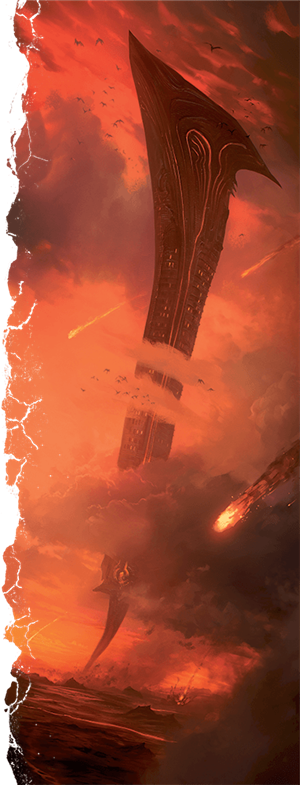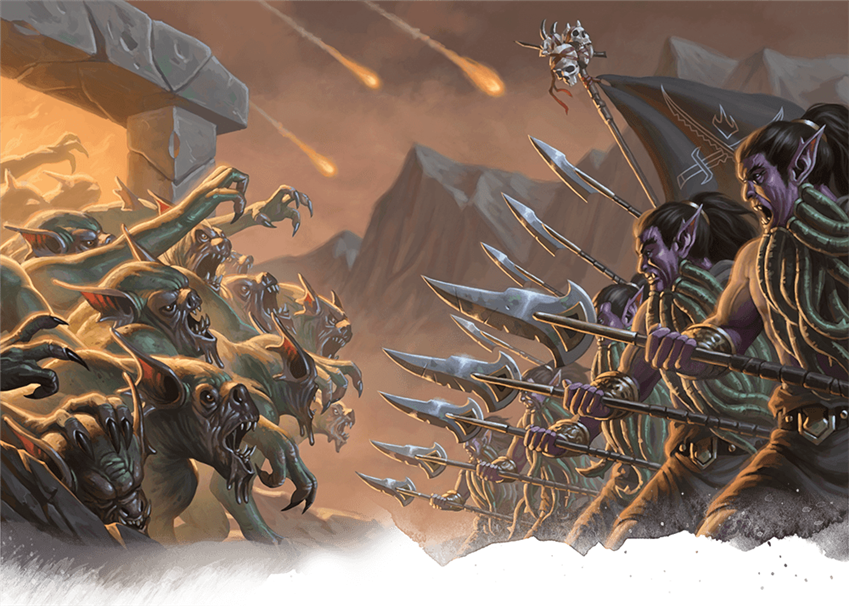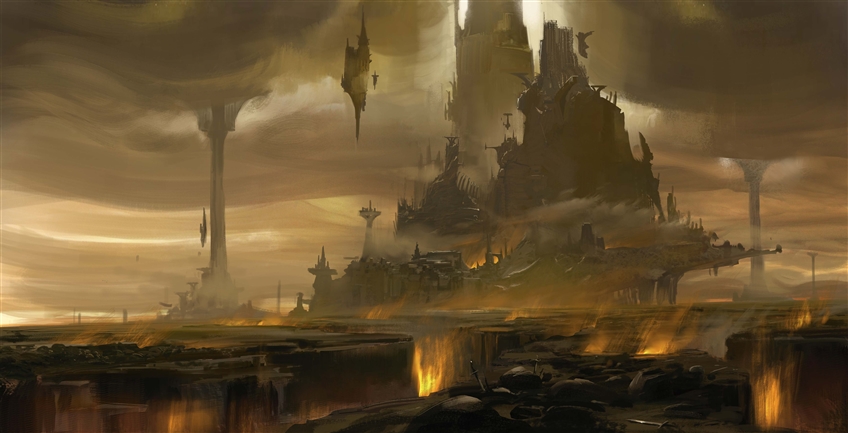 You might think of Hell in a very classical sense—a fiery pit of damnation, one singular location. Readers of Dante's Inferno may be a bit more au fait with the many layers of Hell, which run the gamut from frost-bitten icy wastes through fetid swamps and red-hot palaces of temptation and anger. You may also be aware of other concepts of Hell or the Underworld, such as Tartarus and Hades from Greek mythology, the metaphysical Islamic Jahannam, or even more modern concepts, like The Good Place's Bad Place.
You might think of Hell in a very classical sense—a fiery pit of damnation, one singular location. Readers of Dante's Inferno may be a bit more au fait with the many layers of Hell, which run the gamut from frost-bitten icy wastes through fetid swamps and red-hot palaces of temptation and anger. You may also be aware of other concepts of Hell or the Underworld, such as Tartarus and Hades from Greek mythology, the metaphysical Islamic Jahannam, or even more modern concepts, like The Good Place's Bad Place.
What you may not know—a lot of these already exist in D&D, and have a rich, detailed backstory —some of which my D&D group and I are exploring in Agents of the Nine Hells, which streams at twitch.tv/dnd on Mondays. In this article, I'll run through some of the updating I've done, and I'm a big fan of using the existing material to expand further on concepts of Hell—some of which I'll run through here too.
In Baldur's Gate: Descent Into Avernus, players are given their first view of Hell from a D&D perspective: the fiery sands of Avernus, with a modern dieselpunk Mad Max spin. D&D aficionados will know that Avernus is just the first of the Nine Hells ,and that the Nine Hells are only one of many other Lower Planes of existence in the Multiverse, joined by Acheron, Gehenna, Hades, Carceri, the Abyss and Pandemonium—all of which have their own unique flavor.
Well-Multiversed
The D&D cosmology has undergone many iterations through various editions of the game, and the fifth edition Dungeon Master's Guide lays a few of them out, while the Player’s Handbook presents the Great Wheel as the default configuration of the planes. In the Great Wheel, the Material Plane sits at the center of all things, surrounded and overlapped by the Ethereal Plane, the Feywild, and the Shadowfell, as well as the Elemental Planes of Fire, Earth, Water and Air. At the edge of this cosmology, in a ring around the Inner Planes, lie the Outer Planes—defined around the classic alignments (i.e., Lawful Good, etc.), they are where souls are sent after death to live in their idealised environments. And the evil-aligned ones generally tend to be known as the Lower Planes. Surrounding the infinite-yet-discrete Outer Planes is the Astral Plane, a sea of thoughts and dreams that permits passage between the Outer Planes. Likewise, between the Inner and Outer Planes lies the Elemental Chaos, a churning sea of primordial matter where the elemental planes have bled together.
Mordenkainen's Tome of Foes expands on two major defining aspect of the Lower Planes: the Blood War, the endless conflict between demons and devils; and the River Styx, which runs through all of the Lower Planes and functions as a permanent portal between them. The Blood War itself functions as a backdrop to many an adventure in the Lower Planes; there's always some kind of conflict or power-struggle happening, and both Mordenkainen’s and Descent into Avernus help flesh out a lot of the reasoning behind it and give some big example battles to work with.

Between Two Evils
However, the Lower Planes are wide, and the Blood War isn't just fought on Avernus. Perhaps unsurprisingly, a lot of the fighting happens in the three planes that sit between the Nine Hells and the Abyss: Gehenna, Hades and Carceri. Drawing into some of the old-school lore, the arguably biggest battlefield of the entire conflict is almost immediately at the center point between the two: the Field of Nettles, in Hades.
Originally introduced in 1996 in the seminal Hellbound: The Blood War, the Field of Nettles is a gigantic expanse of blood-sucking nettles covering a 300 mile-wide split in the Styx. The most contested battleground in all of the Blood War, the Field of Nettles sees almost continuous raging conflict, as well as scavengers picking over the bodies for lost items. It was the subject of a titular adventure as part of the above, and is a perfect place to set an adventure in the Lower Planes. I created a statblock for the fiendish bloodthorn (originally from third edition Fiend Folio), a blood-sucking plant that could either sit between the nettles, or be the basis of the entire location. Because of the scavenging opportunity, it might also be a great place to throw in some classic extraplanar favorites, like modrons and slaadi.
Use the bloodthorn in your own D&D game using these homebrew monster statistics.
Staying on Hades, the other famed location of the top layer (Oinos) is the yugoloth home, Khin-Oin—a giant tower, made of a slain deity's backbone. First mentioned in Gary Gygax's Queen of the Spiders back in 1986, it is rumoured to be the birthplace of the entire yugoloth race, although I'm not going to go into too much detail here as that's a major plot point of Agents of the Nine Hells... Suffice it to say that, as a Lower Planes location goes, it's the perfect combination of an evocative image to work with, and non-specific enough to be a canvas for how you want to tell your story in the Lower Planes.
For example, in Agents of the Nine Hells, I combined the concept of Khin-Oin (a gigantic tower) with some yugoloth lore (they are spawned on Hades but tend not to stay there) and some of the adventure's themes (collapsing grandeur and many, many references to Apocalypse Now and media inspired by it, including the incredible Spec Ops: The Line) to turn the location into a disintegrating metropolis: an abandoned Dubai-like city, which should see the party travel through collapsing skyscrapers to reach the tallest tower, for which the Burj Khalifa makes an excellent reference point.
That doesn't mean that your Khin-Oin needs to be the same as mine – if any location can be eldritch enough to look like many different things at once, it's in the Outer Planes. Yugoloths also make for an interesting element to an adventure in the Lower Planes in general – as they are also fiends, like demons and devils, but play off both sides for profit. The details given about them in the Monster Manual, as well as in Mordenkainen’s Tome of Foes, are a great start, but diving deep into old books can also help you find some truly terrifying additions to your adventures. The below is for a Corrupter of Fate, a yugoloth bounty hunter, with special powers based around bad luck.
Use the Corruptor of Fate in your own D&D game using these homebrew monster statistics.

Abandon All Hope
Moving on from Hades, both Gehenna and Carceri continue themes of different kinds of hellish environment. Gehenna offers a very classic “hot” hell, with a volcanic theme and a fascinating landscape quirk that will be sure to liven up an adventure: the entire plane is perceived as if the ground is at an (at least) 45 degree angle. Everything sits on an eternal slope. If you're planning an adventure around the River Styx, this creates instant rapids!Hellbound again mentions a lovely location, the Bridge at Khalas, which is another hotly contested battleground of the Blood War. This could work beautifully as location for a Bridge over the River Kwai-style conflict, or an encounter involving traveling across, or holding the line thereon against an army of fiends. The volcanic landscape of Gehenna is also begging for fiery fiendish/elemental crossover creatures. One we're using in Agents of the Nine Hells is the terrifying phiuhl (again, adapted from the third edition Fiend Folio), a living cloud of volcanic vapour.
Use the phiuhl in your own D&D game using these homebrew monster statistics.
Gehenna is also (now) home to the yugoloths – with no location quite so famous as the Crawling City. First mentioned in the first edition Manual of the Planes, the Crawling City belongs to the ruler of the yugoloths, the mythical General of Gehenna, and is most notable for existing entirely on the back of thousands of fiendish, fire-immune legs, allowing it to crawl over the surface of Gehenna and avoid dangerous lava flows. If that doesn't sound like a James Bond villain level evil lair, I don't know what does! The potential for disrupting the legs and getting the city caught in volcanic activity also strikes me as a potentially excellent plot twist. And again—the details of the city are very much left to your own twisted imagination.
The other of the Lower Planes that we spend some time in for Agents of the Nine Hells is Carceri, which bears a lot of resemblance toTartarus of Greek mythology, with the land being a swamp of despair, and the plane itself being a living prison. The fifth edition Dungeon Master's Guide features a guide on minor effects that each Outer Plane could exhibit if players spend time there, and Carceri's is delightfully simple: any form of magical planar travel or teleportation is hindered, with only permanent gates (and the Styx) functioning as ways in and out of the plane. For seasoned planar travellers, so simple an effect can be a jarring change of pace, and create a very different kind of Hell from the others.
Carceri also has jailers: a whole subspecies of fiend that has not yet been fully explored in fifth edition: the demodands. These fiends, who have featured in a variety of Dungeons and Dragons supplements over the years, received their most famous outing in Drizzt Do'Urden novel The Halfling's Gem. I have created fifth edition versions of the classic shator and kelubar, but the beings I am enjoying most throwing at my players are the farastu – their particularly strange ability to adhere themselves to almost anything made for quite the peculiar encounter!
Use the farastu in your own D&D game using these homebrew monster statistics.
This is only a small selection of thoughts around the Lower Planes – we haven't explored all of them, nor the many different levels of each of the above planes, so there's still much to explore. While there aren’t any modern books delving into these planes, novels and sourcebooks from older editions contain a huge amount of lore that, with a bit of homebrew updating, should add new depth to your stories in the Lower Planes.
And if you're interested in seeing an adventure set around the Lower Planes: Agents of the Nine Hells runs Mondays at twitch.tv/dnd and twitch.tv/adventurerswanted, and you can catch up on our adventures so far at youtube.com/adventurerswanted.
 Chris Hislop is an openly transgender Games Master, one of the Creative Producers of Adventurers Wanted (UK), and the Dungeon Master for their current streamed game Agents of the Nine Hells. With Adventurers Wanted (UK), Chris has written and performed as Dungeon Master in previous adventures Omen, Banishment, Rebellion, Plague and Odyssey, and plays in currently monthly adventure Undergods. Chris is also a freelance theatre publicist, and lives in London. They can be found on Twitter at @chrishislop, and Adventurers Wanted (UK) can be found at @adventurers250.
Chris Hislop is an openly transgender Games Master, one of the Creative Producers of Adventurers Wanted (UK), and the Dungeon Master for their current streamed game Agents of the Nine Hells. With Adventurers Wanted (UK), Chris has written and performed as Dungeon Master in previous adventures Omen, Banishment, Rebellion, Plague and Odyssey, and plays in currently monthly adventure Undergods. Chris is also a freelance theatre publicist, and lives in London. They can be found on Twitter at @chrishislop, and Adventurers Wanted (UK) can be found at @adventurers250.








-
View User Profile
-
Send Message
Posted Dec 11, 2019These four creatures look like great adds - thanks!
-
View User Profile
-
Send Message
Posted Dec 11, 2019I
-
View User Profile
-
Send Message
Posted Dec 11, 2019You should add an https:// to that link so it auto-formats correctly :)
(The space before the second dash also seems out of place...)
-
View User Profile
-
Send Message
Posted Dec 11, 2019This will be a great improvement to Descent into Avernus. Thanks!
-
View User Profile
-
Send Message
Posted Dec 11, 2019Yes! Finally, demodands are starting to get the respect they deserve.
-
View User Profile
-
Send Message
Posted Dec 12, 2019Yugoloths deserve their own adventure module, but they are always put aside for the devils and demons. This makes me sad.
-
View User Profile
-
Send Message
Posted Dec 12, 2019See, in my opinion the middle and outer Lower Planes are underplayed. People tend to overlook places like Pandemonium and Carceri (Prison and pandemonium? I'm having middle school locker room flashbacks!) because they jump straight to the word "demon" or "devil". On top of that, WoTC hasn't really released any lore or adventures for these planes yet in 5e, which is a mistake. I mean, who doesn't love a plane of eternal prison. *offstage* (No one cares, Kurtulmak! SHUT UP!)
-
View User Profile
-
Send Message
Posted Dec 12, 2019Pandemonium makes a brief appearance in the Rrakma adventure. The problem of that plane is that it's essentially an endless labyrinth of madness-inducing wind and noise. Great to visit, so to speak, but fairly difficult to stay there long term without destroying the players.
Me? I'd love to see some official material delve into the elemental planes. The problem, as I see it, is that most of the material from ages past tends to put the four planes all together, then puts them into source books with a bunch of the other Upper Planes, resulting in very brief guides to those locales. That worked fine for iterations where, for example, the Plane of Air is endless sky with only the rare settlement on a mote of earth or some sort of cloud-based structure. If those locations are actual places of life, however? You need more than a chapter shared by all four planes.
-
View User Profile
-
Send Message
Posted Dec 12, 2019Eh, I don't think Pandemonium is underplayed. The problem is that its optional rule, harsh environment even for lower plane standards, and general lack of a real reason to go there tend to make it nigh unplayable. I agree with you about the other lower planes though. Acheron, Gehenna, Carceri, and Hades are all really cool (Hades's opt. rule is harsher than Pandemonium's, but in general I just think players have more of a reason to go to Hades, and that Hades is generally more interesting.)
-
View User Profile
-
Send Message
Posted Dec 12, 2019I'm running a game in the Outlands, so these planar foes are incredibly useful.
-
View User Profile
-
Send Message
Posted Dec 12, 2019wow
-
View User Profile
-
Send Message
Posted Dec 13, 2019Great content! I appreciate the way you delineate reference points between the classic material and your sources of inspiration; these are the elements of creativity that add color to people's campaigns. Inspiring us to "Think outside the Sphere", in the Planescape sense, and to make these worlds ours to design.
-
View User Profile
-
Send Message
Posted Dec 13, 2019Hey! I am a kobold you know!
-
View User Profile
-
Send Message
Posted Dec 14, 2019I'm thinking of running a campaign on the elemental planes.
-
View User Profile
-
Send Message
Posted Dec 15, 2019The Djinn cities, particularly the City of Brass, are excellent places to start with if you want a “safe” block to build off of.
There are even street maps for the City of Brass, if you are interested in some urban adventures between expeditions into the alien and inhospitable landscape.
-
View User Profile
-
Send Message
Posted Dec 16, 2019Thank you everyone, for the feedback and thoughts :) Thoroughly recommend adventuring in the City of Brass as well!
-
View User Profile
-
Send Message
Posted Dec 16, 2019Now this is the content I'm here for! Best article on D&D Beyond yet!
-
View User Profile
-
Send Message
Posted Dec 19, 2019Great article. Anyone know of a list of all the old source books that cover the lower planes?
-
View User Profile
-
Send Message
Posted Dec 20, 2019Superb article and creatures! Thanks.
-
View User Profile
-
Send Message
Posted Dec 30, 2019Does Chris being "openly transgender" affect their ability to play DnD? I ask only because It's not a criterion at my table. I don't care if you wear a MAGA hat, a pride shirt, vote Conservative, Liberal/Progressive, Democrat, Republican, are a practicing member of a religious faith, agnostic, pacifist, an IRL grizzled veteran, LGBTQ, cis-hetero, a particular race or ethnicity, voted "Brexit" or "Remain", I don't care. My criteria are twofold, are you wanting to play in the world I present, and do you have a modicum of basic social skills?